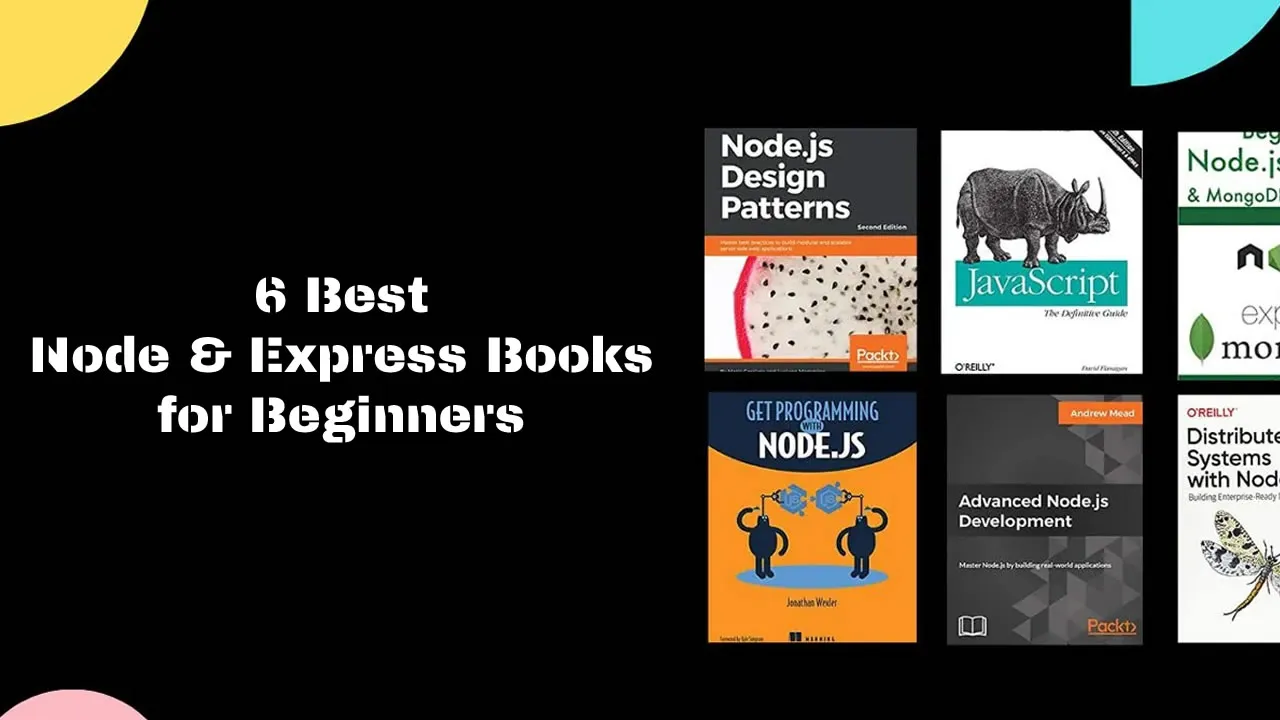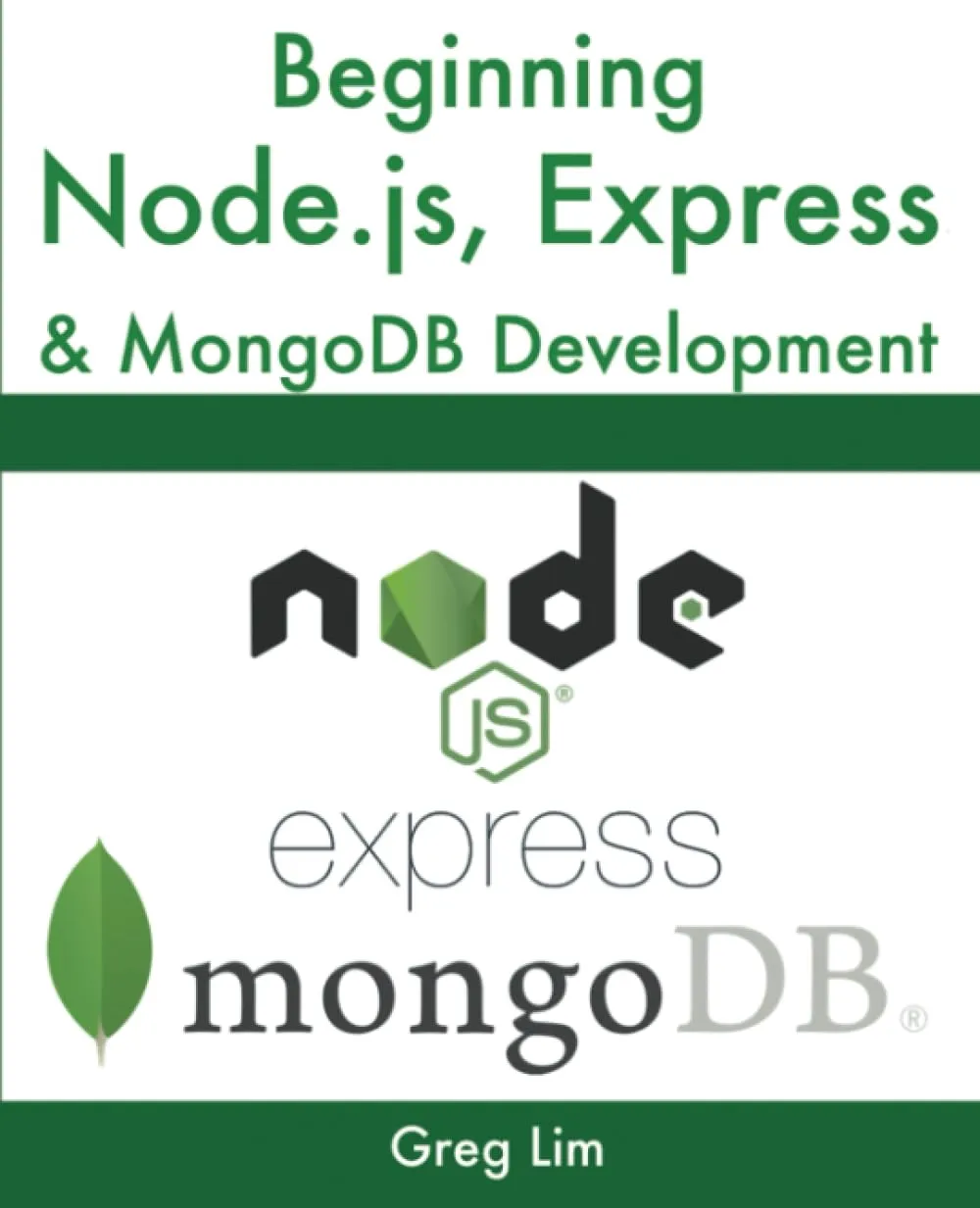6 Best Node and Express Books for Beginners
Learn Node and Express with these top 6 books for beginners. These books will teach you the basics of Node and Express, as well as how to build full-stack web applications. Whether you're a complete beginner or have some experience with JavaScript, these books will help you take your Node and Express skills to the next level.
Here are the top books for Node and Express:
1. Best Book for Hands-on Learners: Web Development with Node and Express: Leveraging the JavaScript Stack
Web Development with Node and Express by Ethan Brown teaches you Express fundamentals by walking you through the development of an example application. This hands-on guide covers everything from server-side rendering to API development suitable for use in single-page apps (SPAs).
The examples in this book can be used with any system that Node works on. After reading the book, you will be able to:
Create a templating system for rendering dynamic data
Dive into request and response objects, middleware, and URL routing
Simulate a production environment for testing
Persist data in document databases with MongoDB and relational databases with PostgreSQL
Make your resources available to other programs with APIs
Build secure apps with authentication, authorization, and HTTPS
Integrate with social media, geolocation, and more
Implement a plan for launching and maintaining your app
Learn critical debugging skills
The book is divided into 23 chapters and the contents covered are:
Chapter 1 gives the introduction of Express
Chapter 2 talks about getting started with Node
Chapter 3 talks about Saving Time with Express
Chapter 4 covers Tidying Up
Chapter 5 covers Quality Assurance
Chapter 6 covers the Request and Response Objects
Chapter 7 talks about Templating with Handlebars
Chapter 8 covers Form Handling
Chapter 9 covers Cookies and Sessions
Chapter 10 talks about Middleware
Chapter 11 talks about Sending Email
Chapter 12 covers Production Concerns
Chapter 13 covers Persistence
Chapter 14 covers Routing
Chapter 15 talks about REST APIs and JSON
Chapter 16 covers Single-Page Applications
Chapter 17 covers Static Content
Chapter 18 covers Security
19. Integrating with Third-Party APIs
Chapter 20 covers debugging
Chapter 21 talks about going live
Chapter 22 covers maintenance
Chapter 23 covers some additional resources
Just pick up this book and explore new ways to look at web development.
Other books you may be interested in:
📙 20 Best Python Books for Beginners and Experienced Coders
📘 15+ Best JavaScript Books for Beginners and Experienced Coders
📗 Top 6 React Books for Beginners to Experts
📓 5 Best Next.js Books for Beginners and Experienced Developers
📔 11+ Best Machine Learning Books for Beginners and Pros
📒 25 Best Flutter Books for Beginners and Experienced Developers
📘 Top 10 Angular Books for Beginners to Advanced Developers
📙 10 Best SQL Books for Beginners and Advanced
📕 Top 15 Data Structures and Algorithms Books for Every Developer
2. Best Book for Serious Learners: Beginning Node.js, Express & MongoDB Development
Beginning Node.js, Express & MongoDB Development by Greg Lim takes you on a fun, hands-on and pragmatic journey to learning Node.js, Express and MongoDB development. The book will let you start building your first Node.js app within minutes.
The book is divided into sixteen chapters. Every chapter is written in a bite-sized manner and straight to the point. The contents covered are:
Chapter 1 gives you the introduction
Chapter 2 gives an introduction to npm and Express
Chapter 3 talks about beginning Blog Project
Chapter 4 covers Templating Engines
Chapter 5 gives an introduction to MongoDB
Chapter 6 talks about applying MongoDB to Project
Chapter 7 talks about uploading an image with Express
Chapter 8 gives an introduction to Express Middleware
Chapter 9 covers Refactoring to MVC
Chapter 10 covers User Registration
Chapter 11 covers User Authentication with Express Sessions
Chapter 12 talks about showing Validation Errors
Chapter 13 talks about relating Post Collection with User Collection
Chapter 14 talks about adding a WYSIWYG Editor
Chapter 15 talks about using MongoDB Atlas
Chapter 16 covers Deploying Web Apps on Heroku
By the end of the book, you will have the skills to create a blog app and deploy it to the Internet.
3. Best Book for Completionists: Node.js Web Development: Server-side web development made easy with Node 14 using practical examples, 5th Edition
Node.js Web Development by David Herron helps you to build scalable web applications using Node.js, Express.js, and the latest ECMAScript techniques. The book takes you through the different stages of developing robust and scalable apps using Node.js 14.
You will learn to deploy applications with AWS and Docker with this updated edition. After reading the book, you will be able to:
Install and use Node.js 14 and Express 4.17 for both web development and deployment
Implement RESTful web services using the Restify framework
Develop, test, and deploy microservices using Docker, Docker Swarm, and Node.js, on AWS EC2 using Terraform
Get up to speed with using data storage engines such as MySQL, SQLite3, and MongoDB
Test your web applications using unit testing with Mocha, and headless browser testing with Puppeteer
Implement HTTPS using Let's Encrypt and enhance application security with Helmet
This book is divided into fourteen chapters and includes the following topics:
Chapter 1 talks about Node.js
Chapter 2 talks about setting up Node.js
Chapter 3 explores Node.js Modules
Chapter 4 covers HTTP Servers and Clients
Chapter 5 talks about your first Express Application
Chapter 6 talks about implementing the Mobile-First Paradigm
Chapter 7 covers Data Storage and Retrieval
Chapter 8 talks about authenticating users with a Microservice
Chapter 9 covers Dynamic Client/Server Interaction with Socket.IO
Chapter 10 talks about deploying Node.js Applications to Linux Servers
Chapter 11 talks about deploying Node.js microservices with Docker
Chapter 12 covers deploying a Docker Swarm to AWS EC2 with Terraform
Chapter 13 covers Unit Testing and Functional Testing
Chapter 14 talks about Security in Node.js Applications
The book helps to build and deploy your own apps on a public web hosting solution. By the end of this Node.js book, you will have gained practical Node.js web development knowledge. This book is for anyone with the desire to learn.
4. Best Book on a Budget: Node.Js in 8 Hours: For Beginners, Learn Coding Fast!
Node.js in 8 Hours by Ray Yao is free with Kindle Unlimited. The book covers all essential Node.js language knowledge. You can learn complete primary skills of Node.js programming fast and easily.
The book includes more than 60 practical examples for beginners and includes tests & answers. The contents covered in the book are:
Hour 1 covers Node.Js Introduction and Node.Js Installation
Hour 2 covers Node.Js Function and Imbedded Function
Hour 3 covers EventEmitter Examples and Error Event
Hour 4 talks about how to write to Buffer and read from Buffer
Hour 5 talks about File Stream and Read Stream
Hour 6 talks about opening a File and File Status
Hour 7 covers how to create and read a Directory
Hour 8 talks about OS Module and Path Module
In the long run, this book will save you a lot of time and make complex things simple and easy to understand.
5. Best Book for Practical Learners: Learning Node: Cookbook, 4th Edition

Node Cookbook: Discover solutions, techniques, and best practices for server-side web development with Node.js 14, 4th Edition by Bethany Griggs helps you to get started with creating, debugging, and deploying your Node.js applications. The book covers solutions to common problems along with tips to avoid pitfalls.
The fourth edition of the Node Cookbook is updated with the latest Node.js features and the evolution of the Node.js framework ecosystems. Here's what you'll learn from the book:
Understand the Node.js asynchronous programming model
Create simple Node.js applications using modules and web frameworks
Develop simple web applications using web frameworks such as Fastify and Express
Discover tips for testing, optimizing, and securing your web applications
Create and deploy Node.js microservices
Debug and diagnose issues in your Node.js applications
The book is divided into twelve chapters and includes the following contents:
Chapter 1 introduces Node.js 14
Chapter 2 talks about Handling I/O
Chapter 3 covers Streams
Chapter 4 talks about using Web Protocols
Chapter 5 talks about developing Node.js Modules
Chapter 6 talks about working with Web Frameworks
Chapter 7 talks about persisting to Databases
Chapter 8 covers Testing with Node.js
Chapter 9 talks about dealing with Security
Chapter 10 talks about Optimizing Performance
Chapter 11 talks about deploying Node.js Microservices
Chapter 12 talks about Debugging Node.js
The book has comprehensive examples covering a lot of practical problems. It is a great read for anyone trying to expand their Node knowledge. If you use nodeJS for writing microservices this book is a great resource!
6. Best Node reference: Node.js Design Patterns, 3rd Edition

Node.js Design Patterns: Design and implement production-grade Node.js applications using proven patterns and techniques, 3rd Edition by Mario Casciaro and Luciano Mammino guides you to learn how to create solid server-side applications by leveraging the full power of Node.js 14. The book helps you to master well-known design principles to create applications that are readable, extensible, and that can grow big.
With this book, you'll learn to:
Leverage Node.js streams to create data-driven asynchronous processing pipelines
Implement well-known software design patterns to create production-grade applications
Share code between Node.js and the browser and take advantage of full-stack JavaScript
The book contains thirteen chapters:
Chapter 1: The Node.js Platform
Chapter 2: The Module System
Chapter 3: Callbacks and Events
Chapter 4: Asynchronous Control Flow Patterns with Callbacks
Chapter 5: Asynchronous Control Flow Patterns with Promises and Async/Await
Chapter 6: Coding with Streams
Chapter 7: Creational Design Patterns
Chapter 8: Structural Design Patterns
Chapter 9: Behavioral Design Patterns
Chapter 10: Universal JavaScript for Web Applications
Chapter 11: Advanced Recipes
Chapter 12: Scalability and Architectural Patterns
Chapter 13: Messaging and Integration Patterns
Throughout the book, you'll see Node.js in action with the help of several real-life examples leveraging technologies such as LevelDB, Redis, RabbitMQ, and ZeroMQ. It's a perfect resource for both beginners and advanced developers.
#node #nodejs #express #expressjs #javascript #js








